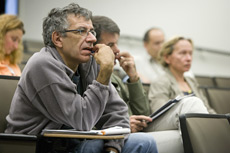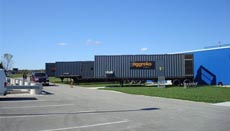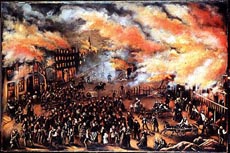|
Monday, Oct. 6
2:30 p.m.
Particle Astrophysics Seminar - Curia II
Speaker: Michael Ramsey-Musolf, University of Wisconsin
Title: Electroweak Baryogenesis, Electric Dipole Moments, and the LHC
3:30 p.m.
DIRECTOR'S COFFEE BREAK - 2nd Flr X-Over
4 p.m.
All Experimenters' Meeting - Curia II
Special Topics: CMS Installation and Commissioning;
DZero Data Processing and Monte Carlo Simulation
Tuesday, Oct. 7
3:30 p.m.
DIRECTOR'S COFFEE BREAK - 2nd Flr X-Over
THERE WILL BE NO ACCELERATOR PHYSICS AND TECHNOLOGY
SEMINAR TODAY
Click here for NALCAL,
a weekly calendar with links to additional information. |
|
Monday, Oct. 6
- French Quarter gumbo
- French dip w/horseradish cream sauce
- Smart cuisine: Santa Fe pork stew
- Smart cuisine: honey mustard chicken
- *Spicy hot Greek wrap
- Assorted sliced pizza
- Sweet 'n' sour chicken w/egg roll
*Carb restricted alternative
Wilson Hall Cafe Menu |
|
Wednesday, Oct. 8
Lunch
- Northern Italian lasagna
- Caesar salad
- Cassata
Thursday, Oct. 9
Dinner
- Closed
Chez Leon Menu
Call x4598 to make your reservation. |
|
|
Labs and companies collaborate on pixel detector technology

More than 70 people attended the Pixel08: International Workshop on Semiconductor Pixel Detectors for Particles and Imaging workshop at Fermilab Sept. 23-26.
Fermilab hopes to greatly improve the performance of its next generation
of particle detectors by partnering with business to boost innovation.
The laboratory reached out to businesses interested in 3D vertical integrated
silicon technology through last week's international workshop about the future
of pixel detectors.
Currently, particle detectors use 2D technology. The new technology would allow scientist to layer silicon circuits to build more compact detectors, saving space, minimizing the material budget and improving the functionality of the detectors. That would allow for better precision in the determination of the particles' path close to the collision point.
Fermilab has been a pioneer in the development of the 3D vertical integrated pixel detector technology, said Fermilab physicist Marcel Demarteau. Industry's infrastructure could accelerate the speed with which the technology can be enabled for high energy physics experiments.
"By partnering with industry we can gain access to commercial process standards with some of the largest silicon foundries in the world," Demarteau said.
Physicists use pixel detectors to study particles that escape from high-energy collisions in particle accelerators. Pixel detectors, which look like a checkerboard of square silicon sensors half the width of a human hair, wrap around the collision site in two to four layers. When particles escape from a collision, they pass through the sensors, depositing charges in the pixels that mark their paths.
Companies use similar 3D technology for tasks such as improving information processing and memory in cell phones and research tools like Field Program Gate Arrays, FPGA. Representatives of Naperville-based Tezzaron Semiconductor and Yokohama, Japan,-based ZyCube attended the Pixel08 workshop along with more than 70 researchers ranging from senior experimentalists to graduate students.
Because research laboratories are on the cutting-edge of technology they usually design their own equipment but, unlike businesses, research laboratories normally order a small number of parts and have difficult access to large scale industrial vendors for their R&D proiects. This can leave researchers waiting for a year for parts, Demarteau said.
However, if a laboratory can get a business like Tezzaron to craft its technology, the process can be very expedient, he said.
The Fermilab pixel group is very excited about this new technology, Demarteau said.
"We're blazing a new trail" he said, "and hope many will follow us"
-- Kathryn Grim
|
Grid Computer Center takes power outage precautions

Computer users at Fermilab's Grid Computing Center won't notice today's power outage thanks to advance planning by the Computing Division's Facilities Operations Department. Last week, generators on semi-trailers were positioned next to the building (pictured) and prepared to supply power during the scheduled maintenance period. Without the rented generators, the power interruption would derail experiment data analysis programs, some of which take several days to complete. With the mobile generators plugged in, the PCs will hum along uninterrupted just like every other day.
|
reCAPTCHA service helps CD reduce spam

The Computing Division uses the reCAPTCHA service to reduce spam from online forms that use the central form-to-e-mail service.
To reduce the amount of spam to employees from online Fermilab forms that use a the central form-to-e-mail service, the Computing Division has added a new protection system. The reCAPTCHA service, created at Carnegie Mellon University, requires users to look at a picture or hear a sound and then type what they saw or heard in order to submit the form.
Since we began using this system, we have seen a reduction in spam to employees from online forms. The central form-to-e-mail service is an application that processes input from an online form and e-mails the results.
CAPTCHA stands for Completely Automated Turing Test To Tell Computers and Humans Apart. It is designed to be easily solvable by humans, but hard to solve by computer programs. This prevents would-be spammers from using automated computer programs to submit forms to send their spam. To help further prevent spam, the central form-to-e-mail service already restricts recipients of the e-mails to a list of approved addresses, which includes fnal.gov addresses.
The central form-to-e-mail service will automatically use the reCAPTCHA service for any Web form submitted. Alternatively, anyone creating a Web form that uses the central-form-to-e-mail service can use these instructions to put the reCAPTCHA service directly into their form, eliminating an additional pop-up window for users. Users or Web authors can contact the Computing Division Helpdesk if they have questions about the new service.
-- Computing Division Central Services Group Web Team
|
|
|
Fire Prevention Week

The National Fire Prevention Week was inspired by the Great Chicago Fire on Oct. 8, 1871. This year's prevention week takes place Oct. 5-12.
Sunday started the annual National Fire Prevention Week, an event to remind us of the importance of taking precautions to prevent fire at homes.
The theme for this year's fire prevention week, which takes place Oct. 5-12, is prevent home fires.
Home structure fires accounted for 80 percent of fire deaths in 2006. That same year, there were The 396,000 home fires in 2006 resulted in 2,580 deaths, 12,500 injuries and $6.8 billion in direct losses. Most fires were caused by cooking equipment (38 percent) or heating equipment (19 percent). Fatality rates and fire rates were comparable, except in fires where smoking was the cause. Smoking caused 4 percent of fires, but 24 percent of deaths.
The Fermilab Fire Department would like to remind you that it is important to continue home fires safety practices year round. You can prevent most home fires with a few simple checks in and around the home.
Cooking - Do not leave an operating stove unattended. Keep anything that can catch fire away from the stovetop. Wear short, close fitting or tightly rolled sleeves when cooking. Turn pot handles inward toward the stove when cooking. If a small fire starts in a pan, smother the flames by carefully sliding a lid over the pan.
Heating - Keep combustible materials at least three feet away from heating equipment. Install and maintain smoke and carbon monoxide detectors. Do not leave portable space heaters unattended.
Smoking - If you smoke, do it outside. Use deep, sturdy ashtrays. Keep matches and lighters away from children. Never smoke in a home containing oxygen tanks and devices.
Electronics - Do not use extension cords as permanent wiring alternatives.
Candles - Do not leave candles unattended.
Equipment - Have your furnace cleaned and serviced each year. Clean out your clothes dryer's vent tube once a year.
Prevention is always the best option, but make sure that your family is prepared in case of an emergency. Practice in-home fire drills with both children and adults.
Reference: www.nfpa.org
|
Fermilab connects to worldwide computing grid
From Medill News Service, Oct. 2, 2008
An international computing grid will soon connect the Fermi National Accelerator Laboratory in Batavia to the new atom-smasher in Switzerland as scientists step up their search for the fundamental building blocks of the universe.
The CERN particle accelerator near Geneva and Fermilab can share data on the search for elusive particles such the Higgs boson, a particle theorized to give mass to matter. The Large Hadron Collider eclipsed the Fermilab accelerator as the largest one in the world when it became operational last month.
The collider will produce an estimated 15 milllion gigabytes of data annually, "enough information to create a 13-mile-high stack of CDs," according to Ian Bird, project manager for the worldwide computing grid.
Read more
|
|
Have a safe day!
NALWO Lincoln Park Zoo trip
NALWO, Fermi National Accelerator Laboratory women's organization, will host a trip to Lincoln Park Zoo on Sunday, Oct. 19, from 9 a.m. to 3 p.m. The event is open to anyone associated with the laboratory and their families. A chartered school bus will leave from the Lederman Education Center at 9 a.m. and will return at approximately 3 p.m. The tour cost is $3 a person, but free for children under age 2. Paid reservations for this trip are required and will be accepted through Oct. 14. For more information, and to make your reservation, contact Margie Nagaitsev at mnagaitsev@hotmail.com or (630) 232-7308.
Exciting Explorations! child care program offered
Exciting Explorations!, a child care program for children ages 7-12, will take place Oct. 13, Nov. 24, 25 and 26, depending on interest. A summer camp counselor will lead the program, Two snacks and beverages are provided. Please send a sack lunch. Program cost is $25 a day and payment is due upon reservation. Reservations are due Oct. 8 for the Oct. 13 program and Nov. 19 for the November dates. To register or for more information, contact Mary or Patti in the Children's Center at x3762 or e-mail daycare@fnal.gov.
Flu shot clinics for 2008 season
Use the east entrance of each building for the following clinics: ES&H training room; Oct. 14 from 9 to
11:30 a.m. in the Industrial Center Building's main floor lunch room;
Oct. 21 from 9 to 11:30 a.m. Wilson Hall, ES&H training room.
Active full-time employees, term employees and temporary employees are eligible
for the vaccinations. Not eligible are: contractors, family members of
employees, visitors/experimenters, seasonal employees, dayworkers,
on-call employees and retirees. Register online at
the ES&H homepage
or call ext. 3232. Bring your Fermilab ID card and a completed consent form
from the ES&H homepage. Wear a loose-fitting shirt. Pregnant employees
need a note from a doctor.
New Travel Office form effective Oct. 1
Effective Oct. 1, the Travel Office and Accounting Department will
discontinue the use of the four-part Travel Authorization/ Expense Voucher
(TA/EV). For trips approved on or after Oct. 1, employees should use the
new TA/EV Excel spreadsheet for travel authorization, travel advance and
travel settlement. Trips approved prior to Oct. 1 on the old four-part form
should be completed on that form.
The new form has a procedure section that outlines the travel approval,
advance and reimbursement process. The form is available on the Accounting and Travel Office Web sites.
Additional Activities
|
|